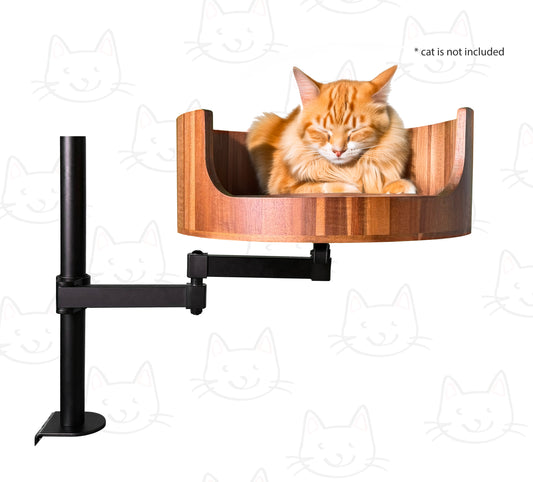
I Found 5 Fleas on My Cat: What to Do Next
Share
If you've discovered that your feline friend has some unwelcome guests in the form of fleas, you may be feeling a bit overwhelmed. It's important to act quickly to prevent the infestation from getting out of control. In this article, we will discuss the steps you should take if you find fleas on your cat, from treating your cat to addressing the issue in your home.
At Desk Cat Nest, we understand the frustration of dealing with fleas and want to provide you with the information you need to effectively combat them. We will cover everything from how to properly inspect your cat for fleas to the best treatment options available. Additionally, we will offer tips on how to rid your home of fleas to prevent reinfestation. By following the advice in this article, you can ensure that your cat is flea-free and your home is a comfortable, pest-free environment for both you and your beloved pet.
1. Fleas can quickly multiply if left untreated, so it's important to take action as soon as possible.
2. Checking your cat regularly for fleas is crucial, especially if they spend time outdoors or around other animals.
3. Treatment options for flea infestations include topical medications, oral medications, and flea collars.
4. It's essential to treat your home as well to prevent re-infestation.
5. Consult with your veterinarian for the best course of action tailored to your cat's specific needs.
Identifying Fleas on Your Cat
If you have discovered 5 fleas on your cat, it is crucial to properly identify them. Fleas are tiny, reddish-brown insects that are commonly found on cats and other pets. To confirm that the pests you found are indeed fleas, you can use a fine-toothed comb to part your cat's fur and look for small, dark insects crawling around. Fleas are fast-moving and may try to evade detection, so be thorough in your search. You may also notice small, black specks (also known as flea dirt) on your cat's fur, which are dried blood left behind by the fleas.
Treating Your Cat for Fleas
Once you have confirmed that your cat has fleas, it is essential to start treatment immediately. There are various flea treatment options available, including topical treatments, oral medications, and flea collars. Consult with your veterinarian to determine the most appropriate treatment for your cat based on their age, weight, and overall health. It is essential to follow the instructions provided with the flea treatment to ensure its effectiveness and prevent any adverse reactions in your cat.
Removing Fleas from Your Home
In addition to treating your cat for fleas, it is essential to address the infestation in your home. Fleas can quickly spread to carpets, furniture, and bedding, creating a cycle of re-infestation. Vacuum your home thoroughly, focusing on areas where your cat spends the most time. Wash your cat's bedding and any other fabric materials in hot water to kill fleas and their eggs. Consider using flea sprays or foggers to target areas where fleas may be hiding.
Preventing Future Flea Infestations
To prevent future flea infestations, it is important to take proactive measures to protect your cat and your home. Use flea prevention products regularly, such as monthly topical treatments or flea collars, to keep fleas at bay. Keep your home clean and vacuum regularly to remove any potential flea eggs or larvae. If you have multiple pets, ensure that all of them are treated for fleas to prevent the spread of infestation. By taking these preventative measures, you can help protect your cat and your home from future flea problems.
Monitoring Your Cat for Signs of Fleas
After treating your cat for fleas and addressing the infestation in your home, it is crucial to monitor your cat for any signs of recurring fleas. Keep an eye out for excessive scratching, biting, or grooming, as these could be indicators of fleas. If you notice any fleas or flea dirt on your cat, repeat the treatment process and continue to take preventative measures to keep fleas under control. Regular monitoring and maintenance are key to ensuring that your cat remains flea-free and healthy.
Desk Cat Nest FAQ
What should I do if I found 5 fleas on my cat?
If you have found fleas on your cat, it is important to act quickly to prevent an infestation. Start by giving your cat a flea bath using a mild shampoo specifically designed for cats. You should also treat your cat with a flea prevention product recommended by your veterinarian. Additionally, it is important to clean your cat's bedding, vacuum your home thoroughly, and consider using a flea spray or bomb to eliminate any remaining fleas in your home.
Is Desk Cat Nest an effective solution for flea prevention?
Desk Cat Nest is not specifically designed to prevent fleas on your cat. While the elevated design of this cat bed can help keep your cat away from potential flea-infested areas, it is still important to use a flea prevention product recommended by your veterinarian to protect your cat from fleas.
Can fleas infest the Desk Cat Nest?
While fleas are more commonly found on pets and in carpeting, it is still possible for fleas to infest your cat's bedding, including the Desk Cat Nest. To prevent this, make sure to regularly clean and wash the cat bed to remove any flea eggs or larvae that may be present. It is also important to treat your cat with a flea prevention product to minimize the risk of infestation.
In conclusion, investing in a Desk Cat Bed is a valuable choice for pet owners who have discovered fleas on their cats. Not only does the raised design of the bed help to keep your cat away from potential flea-infested areas, but the comfortable cushioning and warmth provided by the bed can also help soothe your cat's discomfort. Additionally, the easy-to-clean material of the Desk Cat Bed makes it a practical and convenient solution for maintaining a flea-free environment for your beloved pet. Choosing a Desk Cat Bed is a proactive step towards ensuring the health and well-being of your cat.



















































